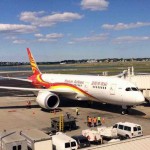Beijing, June 20, 2014 (Global Times), — It is quite rare to see numerous routes opened between China and the United States within two weeks, but this is exactly what is happening now.
Hainan Airlines, the fourth-largest airline in China in terms of fleet size, opens the nonstop route between Beijing and Boston, its third US city after Seattle and Chicago, Friday.

Chinese students from Northeastern University were invited to the ceremony at Boston Logan International Airport to celebrate the arrival of the first nonstop flight from Beijing (photos provided by NUCSSA).
Hainan Airlines is not alone.
On June 12, American Airlines Group Inc started its maiden flight of a nonstop daily service between Shanghai and Dallas, with 240 passengers on board.
This new flight is the airlines’ fourth nonstop route connecting China to the US, with the other three being Shanghai-Chicago, Shanghai- Los Angeles and Beijing-Chicago.
One day earlier, United Airlines launched a nonstop service between Chengdu, capital of Southwest China’s Sichuan Province, and San Francisco in the US, the first nonstop service between the US from central and western China.
At the same week, Air China declared that it is now offering nonstop flights between Beijing and Washington DC four times a week, making the city its seventh destination after New York, Los Angeles, and San Francisco in North America.
In the past, passengers often chose Korean Air, Asiana Airlines, Cathay Pacific Airways or Japan Airlines to the US via Hong Kong, Incheon in South Korea and Narita in Japan.
“The boom is mainly due to the frequent business trips and travelers between the two countries, as well as the economic recovery of the US, which has brought about a big transport demand,” Cao Yin, consulting director of the Martec Group, a US market research and consulting firm, told the Global Times Wednesday.
Figures from the Office of Travel and Tourism Industries under the US Department of Commerce show that China ranked as the seventh-largest international travel market in terms of number of visitors in 2013, with 1.81 million, up 23 percent than in 2012.
However, it is not easy for the domestic airlines to shake the dominant status of US airlines, which have the advantages of fleet size and networks.
In 2010, United Airlines merged with its rival Continental Airlines, which made the new company the largest airline in history, extending its network in China. In April this year, James Compton, who oversees United’s operations, said that the company plans to increase 20 percent of its capacity for China routes in the second quarter of 2014.
Delta Air Lines depends more on cooperation with China Eastern Airlines and China Southern Airlines to extend its network in China.
American Airlines, which entered the Chinese market in 2006, is expected to increase its capacity in China as more routes started.
In an e-mail to the Global Times last week, Hainan Airlines said it will fly to more cities in central and southern US, and it plans to open two or three direct routes from Beijing to eastern and south-central US with Boeing 787 airplanes.
China Eastern also vowed to update its models and frequent the routes. From next Wednesday, the company plans to expand the route between Shanghai to New York from seven times per week to 10 times.
Zhang Wei, an air-mile “millionaire” who is a lifetime platinum card member of Air China in Beijing, told the Global Times that he has flown United Airlines, Delta Air Lines, and Air China in the past 10 years, but he prefers Air China as he found that “their service is sweet,” and he can easily enjoy the preferential policies for air miles in China.
However, he said the network of Air China in the US is not as extensive as its rivals such as Delta and United based there, which makes “transfers not as convenient as expected.”



